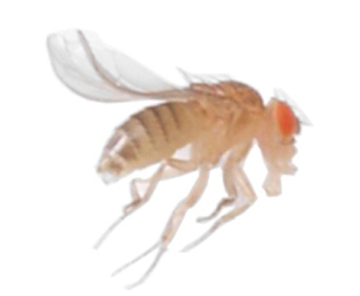'Zero-G' Fruit Flies Aid Human Space Travel Studies

A new study that examines the way magnetic fields that simulate weightlessness on Earth affect how fruit flies walk could help scientists understand microgravity's influence on humans and other animals in space, researchers say.
In November 1957, the Soviet Union launched the first living voyager into orbit, the dog Laika, aboard Sputnik 2. The U.S. space program followed this with flights carrying chimps, such as Enos and Ham, in the early 1960s.
Scientists continue to launch animals into the heavens to learn more about how microgravity and other properties of space might affect biology.
Previous studies have shown that the common fruit fly (Drosophila melanogaster) walks more quickly and frequently in space compared with flies on Earth. However, it was unclear if aspects of space travel other than microgravity might have been responsible for these changes, such as the G-forces felt during launch.
Now, using powerful magnetic fields that simulate microgravity, researchers find that weightlessness does seem to alter fruit fly walking patterns. [6 Everyday Things that Happen Strangely In Space]
Simulating microgravity
Most biological materials are "diamagnetic," Richard Hill, the study's lead author, said.
Breaking space news, the latest updates on rocket launches, skywatching events and more!
"This is a different type of magnetism from what we're familiar with," explained Hill, who is a physicist at the University of Nottingham in England. "What we ordinarily think of as 'magnetic materials' are ferromagnetic materials such as iron — these are strongly attracted by magnetic fields. A diamagnetic material on the other hand is weakly repelled from magnetic fields. This is a very weak force compared to ferromagnetic attraction, so that if you hold a refrigerator magnet up to your hand, for example, you don't notice the repulsive force."
Using superconducting magnets to create very strong magnetic fields of about 16 tesla — about 350,000 times stronger than the strength of the Earth's field, or about 16 times as strong as the most powerful permanent magnets — "then the diamagnetic force can be large enough to just balance the force of gravity so that the object levitates with no support," Hill told SPACE.com.
The advantage of simulating weightlessness on the ground instead of experiments in space, "is that it's a lot cheaper, and we don't have to worry about any effects of the high G-forces launching the flies into space on a rocket," Hill said. "Diamagnetic levitation doesn't balance gravity as perfectly as 'real' weightlessness does in space, but diamagnetic levitation can be used to see which experiments are suitable and interesting to perform in space before spending the money launching them into space."
The investigators saw the fruit flies in simulated microgravity display accelerated walking patterns much like those seen in actual microgravity.
Walk this way
This faster pace "may be because the flies just find moving around in weightlessness easier, or it could be that it's some kind of response to confusion about which way is up and down," Hill said.
"We have to be a bit careful because we are using a strong magnetic field which can have other effects on living organisms," Hill cautioned. "However, we can control for these effects by examining how the flies behave in different parts of the magnet — at the center of our solenoid magnet, there is a strong magnetic field but no diamagnetic force, so the flies experience normal gravity.
"By comparing how flies in the center of the magnet behave with flies outside the magnet, we can isolate the different effects of the strong magnetic field," he said. "We don't see any other effect of the magnetic field on their walking behavior, so our experiment is very similar to the one that was performed on the space station."
Although it's not feasible to use this technique to directly investigate the effects of weightlessness on humans, "by studying the effects on 'model' organisms, such as the fruit fly, we can hope to obtain information about the effects of weightlessness on particular biological mechanisms," Hill said.
"It's also important to remember that, in our endeavors to explore space — setting up permanent bases on Mars, for example, or other planets — it will be crucial to understand the effects of weightlessness on all living organisms," Hill added. "Our survival on permanent off-world settlements will of course require us to take with us many different biological organisms."
The detailed findings of the study were to be published online Dec. 4 in the Journal of the Royal Society Interface.
Follow SPACE.com for the latest in space science and exploration news on Twitter @Spacedotcom and on Facebook.

Charles Q. Choi is a contributing writer for Space.com and Live Science. He covers all things human origins and astronomy as well as physics, animals and general science topics. Charles has a Master of Arts degree from the University of Missouri-Columbia, School of Journalism and a Bachelor of Arts degree from the University of South Florida. Charles has visited every continent on Earth, drinking rancid yak butter tea in Lhasa, snorkeling with sea lions in the Galapagos and even climbing an iceberg in Antarctica. Visit him at http://www.sciwriter.us
